Plant Factory Market by Growing System (Non-soil-based, Soil-based, Hybrid), Crop Type (Fruits, Vegetables, Flowers & Ornamentals, Other Crop Types), Facility Type (Greenhouses, Indoor Farms), Light Type and Region - Global Forecast to 2028
The global plant factory market size was valued at US$ 129 million in 2022 and is poised to grow from US$ 138 million in 2023 to US$ 196 million by 2028, growing at a CAGR of 7.3% in the forecast period (2023-2028). The demand for plant factory market has been steadily increasing over the years due to several factors. One of the main drivers is the growing global population and the need to produce more food in a sustainable manner. Plant factories offer a solution by using advanced technology to grow crops in a controlled environment, allowing for year-round production and higher yields. Additionally, plant factories are able to reduce the amount of water and land required for farming, making them an attractive option for countries facing water scarcity and limited arable land. Furthermore, consumers are increasingly demanding locally grown, pesticide-free produce, which can be provided by plant factories. As a result, the plant factory market is expected to continue growing in the coming years as the demand for sustainable, high-quality produce increases.
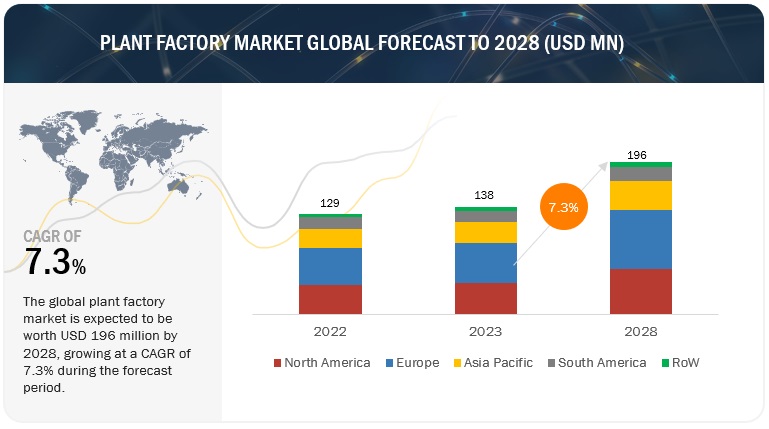
To know about the assumptions considered for the study, Request for Free Sample Report
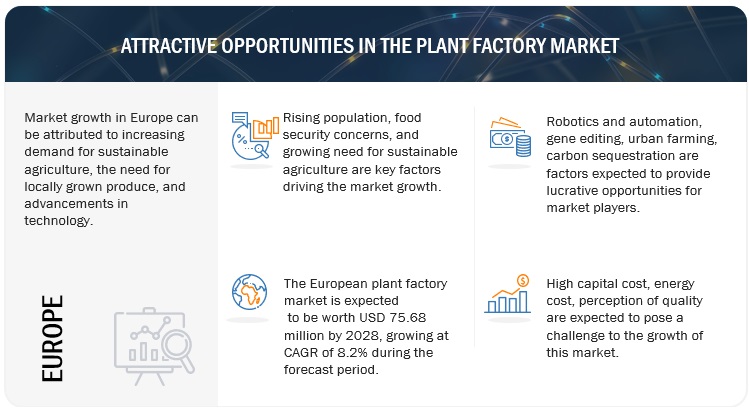
To know about the assumptions considered for the study, download the pdf brochure
Plant Factory Market Dynamics
Driver: Higher yield as compared to traditional agriculture practices.
In order to increase food production, alternative farming techniques like vertical farming have emerged in response to rising food demand and decreasing cropland and fertile soils. These technologies are being used to achieve food self-sufficiency in countries that have suffered with domestic production and supply issues for a long time due to a lack of natural resources and favourable climatic conditions. Lack of arable land, lack of high-quality soil, and increased food demand have led to the development of novel techniques like vertical farming, which is gradually gaining acceptance in many countries. To maximise space, vertical farming involves producing food in stacks or layers. Its benefits include better area utilisation, reliable year-round crop production that is unaffected by weather, and low water and pesticide usage.
Hydroponic farming uses far less water than conventional farming because of the concentrated usage of water. Additionally, the plants only use 0.1% of the water that is available to them, with the remainder being returned to the environment through evapotranspiration. Conventional farming uses a lot of water, but much of it is wasted owing to insufficient irrigation, evaporation, and poor water management. Vertical farming enables efficient use of water, i.e., up to 95% less water compared to traditional farming methods. According to the Columbia University Earth Institute, vertical farmers use 70% to 95% less water than traditional farmers do in plant cultivation.
Restraint: High capital investments
High capital investments can be a significant barrier to entry for new businesses in the plant factory market. According to article by CoBANK 2022, the albatross of vertical farms is their high investment and operating expenses. The initial investment costs of real estate can increase as it gets closer to urban areas. Construction expenses for a single large-scale vertical farming plant could exceed USD100 million, according to estimates from the industry. It should be noted that technological costs tend to decline with time, and farms can relocate to cities with low property values or financial incentives from the local government. By necessity, improving plant growth in vertical farming necessitates significant technological and energy investment to control growing conditions like temperature, light, humidity, oxygen, and CO2 levels.
The high costs associated with building and maintaining these facilities can make it challenging for small or medium-sized businesses to compete with larger corporations. Furthermore, the initial investment required for setting up a plant factory can be significant, and the return on investment may not be realized for several years. This can be discouraging for investors who may prefer to invest in other sectors with a more immediate payoff. Additionally, the cost of technology and equipment required for plant factories can be high. This includes lighting systems, environmental control systems, and specialized equipment for hydroponic or aeroponic growing methods. As a result, companies that cannot afford to invest in the latest technology may struggle to compete with those that can. Overall, the high capital investment required to set up a plant factory can create barriers to entry for new players in the market, limiting competition and potentially leading to market consolidation.
Opportunity: Increased adoption of plant factories by restaurants and grocery stores amid the COVID-19 pandemic
The trend of adoption of indoor farming by restaurants and grocery stores is being fuelled by retailer acceptance and, eventually, public acceptance. Walmart, Kroger, and Albertsons are among the grocery stores that have agreements with indoor growers. Additionally, Publix, which is based in Lakeland, Florida, has introduced an on-site trailer farm from a nearby hydroponic grower. According to a survey conducted in 2021 by FMI, The Food Industry Association, 43% of consumers did not prefer produce grown indoors as opposed to outdoors. Members of Generation Z, who are quickly overtaking baby boomers as America's most influential demographic group, were most likely to prefer indoor sources.
However, many restaurants have advanced the idea of local food in recent years and now accept hyperlocal food, in which restaurants either produce their own produce or source some of it from nearby farms. While promoting sustainability and the local economy, they make an extra effort to provide the best quality ingredients. There are restaurants that source almost all their food locally, known as hyperlocal restaurants. Some restaurants have their own gardens where they produce the vegetables they use in their dishes. Orlando World Centre Marriott resort is also doing the same. In their restaurant, they built a vertical farm with a 4000 cubic feet space. It is a hydroponic system that will yearly produce 13,000 lbs. of other leafy greens, herbs, and micro-greens in addition to 1,10,000 heads of lettuce. That will be used to support the requirements for the hotel's banquets as well as the nine on-site lounges and restaurants. That is, there will be fresh produce and herbs accessible every day. 40 to 50 varieties of produce can be grown and incorporated into the restaurant menus- pick- to- plate within hours for providing maximum freshness.
Challenge: Tapping into the organic food market
According to the Organic Trade Association, in US Organic sales surpassed USD 63 billion between 2020 and 2021, growing by USD 1.4 billion (2%) overall over the year. Food sales, which account for more than 90% of organic sales, increased to USD 57.5 billion (an increase of about 2%), and non-food sales hit USD 6 billion (7 percent growth).
Organic farming is often associated with higher quality and better-tasting produce, which can be a significant selling point for consumers. Plant factories may struggle to replicate the taste and quality of organic produce, which could limit their appeal to certain consumers. Furthermore, organic farming is often supported by government regulations and subsidies, which can make it more financially attractive to farmers than other forms of agriculture. This can make it challenging for plant factories to compete with organic farms on price, as organic farms may be able to offer their products at lower prices due to government support.
Plant Factory Market Ecosystem
Prominent companies in this market include well-established, financially stable manufacturers of plant factory. These companies have been operating in the market for several years and possess a diversified product portfolio, state-of-the-art technologies, and strong global sales and marketing networks. Prominent companies in this market include AeroFarms (US), Gotham Greens (US), BOWERY FARMING INC. (US), Oishii (US), Plenty Unlimited Inc. (US), MIRAI (Japan), Agricool (France), AppHarvest (US), CropOne (UAE) and BrightFarms (US).
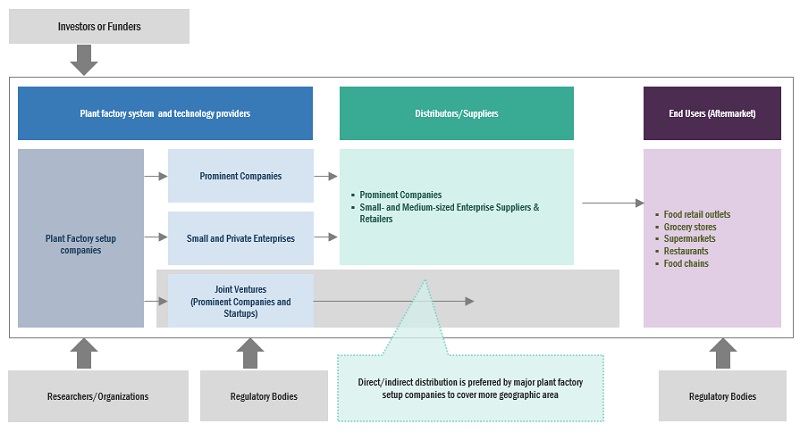
Based on facility type, Indoor farms segment is estimated to account for the second largest market share of the plant factory market
Based on facility type, Indoor farms segment is estimated to account for the second largest market share. Indoor farming, also known as vertical farming, offers several advantages over traditional farming methods. One of the main benefits is the ability to grow crops year-round, regardless of weather conditions. This reduces the risk of crop failures due to extreme temperatures, drought, or pests. Additionally, indoor farming allows for precise control of growing conditions, such as temperature, humidity, and lighting, which can lead to higher crop yields and improved quality. Indoor farming also uses significantly less water than traditional farming methods, as water can be recycled and reused in a closed system.
Full artificial light segment of the plant factory market by light type is projected to witness the highest CAGR during the forecast period.
Based on light type, the full artificial light segment estimated to account for the highest growth rate. Full artificial light, or LED lighting, is a critical component of plant factories, which are indoor farms designed specifically for commercial crop production. LED lighting technology has advanced significantly in recent years, allowing for precise control over the light spectrum and intensity, making it possible to optimize plant growth and increase crop yields. This technology has been a major driver of the plant factory market, as it enables year-round crop production in a controlled indoor environment, independent of weather conditions and seasonal changes.
Based on crop type, Vegetables segment are anticipated to dominate the market.
Based on crop type, the market is segmented into the vegetables, fruits, flowers & ornamentals, other crop types. By providing an ideal growing environment, plant factories can produce vegetables that are more consistent in size, color, and taste, and are free from pesticides and other contaminants. Additionally, plant factories can use advanced technologies such as hydroponics and aeroponics to deliver nutrients directly to the roots of plants, reducing the need for fertilizers and improving the efficiency of nutrient uptake. The result is produce that is free from harmful chemical residues and other contaminants, promoting healthier and safer food for consumers.
The North America market is projected to contribute the second largest share for the plant factory market.
North America is home to a large number of plant factory companies, ranging from start-ups to established players, all focused on developing and scaling innovative solutions to meet the growing demand for fresh, high-quality produce. For instance, Plenty, a San Francisco-based vertical farming start-up that uses machine learning and robotics to optimize plant growth and reduce water usage. Plenty's plant factories are able to produce crops year-round, with up to 350 times more yield per square foot than traditional farming methods. The company has raised over USD 500 million in funding and has partnered with several major retailers and restaurants to provide locally grown produce. According to Agricultural Marketing Resource Centre 2021, greenhouse crops are the top 10 commodities in 42 states and the top five commodities grown in 27 states in the USA. Moreover, ten US states provide more than two-thirds of the nursery crop output grown in greenhouses, with California supplying around 20% of the total. In the United States, greenhouse farming is becoming more and more popular as a means of producing local, fresh vegetables without the need for cold weather.
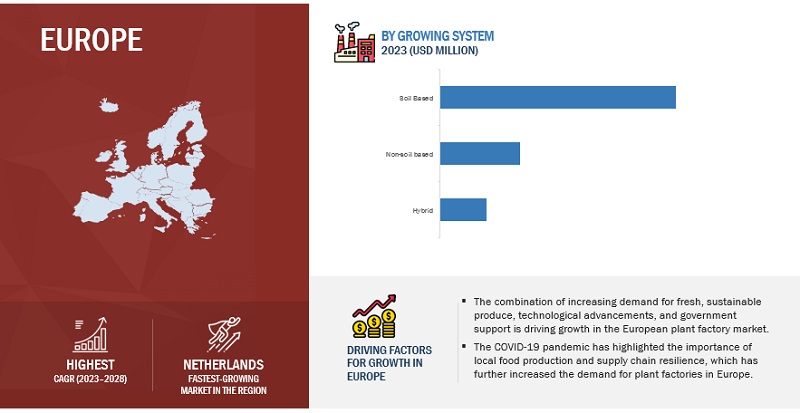
Key Market Players
The key players in this include AeroFarms (US), Gotham Greens (US), BOWERY FARMING INC. (US), Oishii (US), Plenty Unlimited Inc. (US), MIRAI (Japan), Agricool (France), AppHarvest (US), CropOne (UAE) and BrightFarms (US). These players in this market are focusing on increasing their presence through agreements and collaborations. These companies have a strong presence in North America, Asia Pacific and Europe. They also have manufacturing facilities along with strong distribution networks across these regions.
Get online access to the report on the World's First Market Intelligence Cloud
- Easy to Download Historical Data & Forecast Numbers
- Company Analysis Dashboard for high growth potential opportunities
- Research Analyst Access for customization & queries
- Competitor Analysis with Interactive dashboard
- Latest News, Updates & Trend analysis
Request Sample Scope of the Report
Get online access to the report on the World's First Market Intelligence Cloud
- Easy to Download Historical Data & Forecast Numbers
- Company Analysis Dashboard for high growth potential opportunities
- Research Analyst Access for customization & queries
- Competitor Analysis with Interactive dashboard
- Latest News, Updates & Trend analysis
|
Report Metric |
Details |
|
Market size available for years |
2019–2028 |
|
Base year considered |
2022 |
|
Forecast period |
2023–2028 |
|
Forecast units |
Value (USD) |
|
Segments covered |
Growing System (Soil-based, Non-soil-based, and Hybrid), Facility Type (Greenhouses, Indoor Farms, Other Facility Types), Light Type (Sunlight, Full Artificial Light), Crop Type (Vegetables, Fruits, Flowers & Ornamentals, other crop type), and Region |
|
Regions covered |
North America, Europe, Asia Pacific, South America, and RoW |
|
Companies covered |
AeroFarms (US), Gotham Greens (US), BOWERY FARMING INC. (US), Oishii (US), Plenty Unlimited Inc. (US) |
This research report categorizes the plant factory market based on growing system, facility type, light type, crop type, and region.
Based on growing system, the plant factory market has been segmented as follows:
- Soil based
- Non-soil based
- Hybrid
Based on facility type, the plant factory market has been segmented as follows:
- Greenhouses
- Indoor farms
- Other facility types
Based on the light type, the plant factory market has been segmented as follows:
- Sunlight
- Full artificial light
Based on the crop type, the plant factory market has been segmented as follows:
- Vegetables
- Fruits
- Flowers & ornamentals
- Other crop type
Based on the region, the plant factory market has been segmented as follows:
- North America
- Europe
- Asia Pacific
- South America
- RoW (the Middle East & South Africa)
Recent Developments
- In Feb 2023, the Public Investment Fund (“PIF”) signed a joint venture agreement with AeroFarms, to establish a company in Riyadh to build and operate indoor vertical farms in Saudi Arabia and the wider Middle East and North Africa (MENA) region. The joint venture is anticipated to enable year-round, sustainable local sourcing of high-quality crops cultivated on AeroFarms' unique smart agriculture technology ("AgTech") platform, which helps address more general supply chain issues in the sector.
- In Feb 2023, Realty Income Corporation and Plenty Unlimited INC. announced that they have entered into a strategic real estate alliance to support the development of Plenty’s indoor vertical farms. Under the terms of the agreement, Realty Income will acquire and provide development funding for properties that will house Plenty’s indoor farms. These properties leased to Plenty under long-term net leases. The agreement provides for up to USD 1 billion of development opportunities.
- In April 2022, Bowery Farming announced a partnership with The Nature Conservancy (TNC) as part of its’ ‘Earth Month Rewild the Land initiative. With this partnership, Bowery is about to restore 50 acres in the U.S. to support conservation efforts in restoring ecosystem biodiversity and spotlight the rewilding movement, which returns retired farmland and other degraded land to Mother Nature.
- In Sept 2022, MIRAI Co., Ltd. concluded an agreement with ONNNA Greens AS, Norway for the cultivation equipment for a fully closed artificial light-type plant factory for the second expansion phase, in addition to the factory already in operation. This agreement will strengthen the company’s cooperation in the development of various labor-saving equipment.
- In December 2021, For the first operation of Gotham Greens on the West Coast, Gotham Greens, has opened the initial phase of its 10-acre hydroponic greenhouse near the University of California-Davis campus. With this national greenhouse expansion, Gotham Greens will have a network of high-tech hydroponic greenhouses spanning nine facilities in six states.
Frequently Asked Questions (FAQ):
How big is the plant factory market?
The plant factory market is projected to rise from its projected USD 138 million in 2023 to USD 196 million by 2028 at a compound annual growth rate (CAGR) of 7.3%.
Which players are involved in the manufacturing of plant factory market?
The key players in this market include AeroFarms (US), Gotham Greens (US), BOWERY FARMING INC. (US), Oishii (US), Plenty Unlimited Inc. (US), MIRAI (Japan), Agricool (France), AppHarvest (US), CropOne (UAE) and BrightFarms (US). These players in this market are focusing on increasing their presence through agreements and collaborations. These companies have a strong presence in North America, Asia Pacific and Europe. They also have manufacturing facilities along with strong distribution networks across these regions.
Is there Oceania (New Zealand and Australia) specific information (market size, players, growth rate) for the plant factory market?
On request, We will provide details on market size, key players, growth rate of this industry in the Oceania region. Also, you can let us know if there are any other countries of your interest.
What is the future growth potential of plant factory market?
The future growth potential of the plant factory market is significant, buoyed by a convergence of factors propelling innovation in agriculture. With increasing demand for locally sourced, fresh produce coupled with urbanization and the scarcity of arable land, plant factories offer a compelling solution. Technological advancements in automation, artificial intelligence, and environmental control systems are driving efficiency and productivity gains in these indoor farming facilities. Moreover, heightened awareness of climate change and its impact on traditional farming methods underscores the importance of resilient and sustainable agricultural practices, further boosting the appeal of plant factories.
What is the total CAGR expected to be recorded for the plant factory market during 2023-2028?
The CAGR is expected to record a CAGR of 7.3 % from 2023-2028.
To speak to our analyst for a discussion on the above findings, click Speak to Analyst
The study involved four major activities in estimating the current size of the plant factory market. Exhaustive secondary research was done to collect information on the market, peer market, and parent market. The next step was to validate these findings, assumptions, and sizing with industry experts across the value chain through primary research. Both top-down and bottom-up approaches were employed to estimate the complete market size. After that, market breakdown and data triangulation were used to estimate the market size of segments and subsegments.
Secondary Research
In the secondary research process, sources such as annual reports, press releases, and investor presentations of companies, white papers, certified publications, articles from regulatory bodies, trade directories by recognized authors, and databases were used to identify and collect information for this study.
Secondary research was used to obtain key information about the industry’s supply chain, the total pool of key players, market classification, and segmentation according to the industry trends to the bottom-most level, geographic markets, and key developments from both market- and technology-oriented perspectives.
Primary Research
The plant factory market includes several stakeholders in the supply chain, including raw material suppliers, technology and service providers, plant factory setup companies, and regulatory organizations. The demand side of the market is characterized by the presence of food retail outlets, grocery stores, food suppliers & vendors, and processed food manufacturing companies. Key technology and service providers and suppliers of raw materials characterize the supply side.
Various primary sources from the supply and demand sides were interviewed to obtain qualitative and quantitative information. The primary interviewees from the demand side include key opinion leaders, executives, vice presidents, and CEOs from the food & beverage sectors. The primary sources from the supply side include key opinion leaders and key manufacturers in the plant factory market.
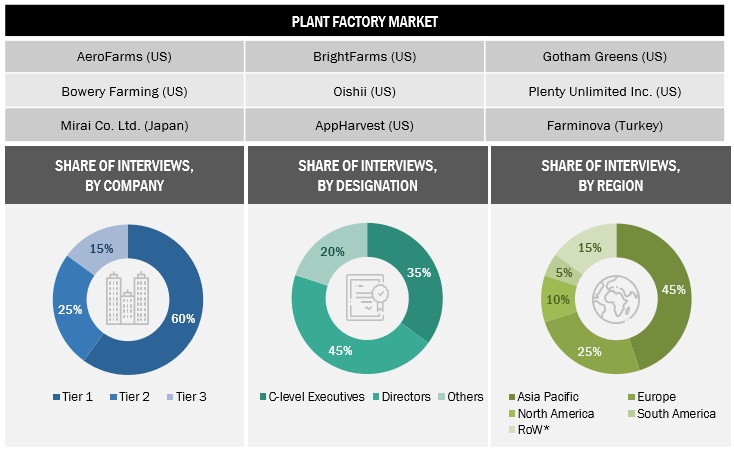
To know about the assumptions considered for the study, download the pdf brochure
Market Size Estimation
The top-down and bottom-up approaches were used to estimate and validate the total size of the plant factory market. These approaches were also used extensively to estimate the size of various subsegments in the market. The research methodology used to estimate the market size includes the following details.
Top-down approach:
- The key industry and market players were identified through extensive secondary research.
- The industry’s supply chain and market size were determined through primary and secondary research.
- All percentage share splits and breakdowns were determined using secondary sources and verified through primary sources.
- The adjacent markets—the hydroponics market and Indoor farming technology market—were considered to validate further the market details of plant factory.
Bottom-up approach:
- The market size was analyzed based on the share of each crop type of plant factory and growing system at regional and country levels. Thus, the global market was estimated with a bottom-up approach at the country level.
- Other factors include demand for crops produced through different growing systems across various facility types; pricing trends; adoption rate and price factors; patents registered; and organic and inorganic growth attempts.
All macroeconomic and microeconomic factors affecting the plant factory market were considered while estimating the market size.
All possible parameters that affect the market covered in this research study were accounted for, viewed in extensive detail, verified through primary research, and analyzed to obtain final quantitative and qualitative data.
Global plant factory market Size: Bottom Up Approach
The bottom-up approach used the data extracted from secondary research to validate the market segment sizes obtained. The approach was employed to determine the overall size of the plant factory market in particular regions. Its share in the plant factory market at the country and regional levels was validated through primary interviews conducted with suppliers, dealers, and distributors.
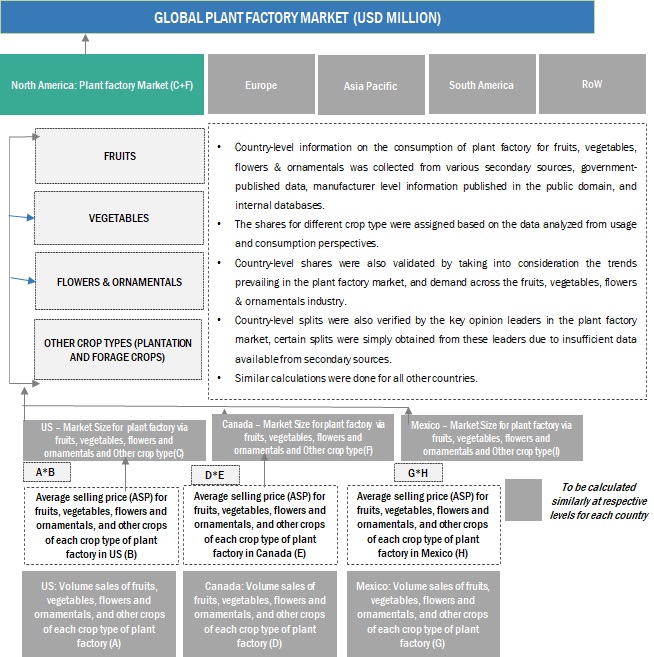
To know about the assumptions considered for the study, Request for Free Sample Report
Global Plant Factory Market Size: Top Down Approach
In the top-down approach, the overall market size was used to estimate the size of individual markets (mentioned in the segmentation) through percentage splits from secondary and primary research.
The top-down approach used to triangulate the data obtained through this study is explained in the next section:
- In the global plant factory market, related secondary sources such as US Department of Agriculture (USDA), Food and Drug Administration (FDA), Ministry of Agriculture, Forestry and Fisheries (MAFF), Association for Vertical Farming (AVF) and Annual Reports of all major players were considered to arrive at the global market size.
- The global number for plant factory was arrived upon after giving certain weightage factors for the data obtained from these secondary and primary sources.
- With the data triangulation procedure and data validation through primaries (from both supply and demand sides), the shares and sizes of the regional markets and individual markets were determined and confirmed.
- Data on company revenues, area harvested, product launches, and global regulations for plant factory in the last four years was used to arrive at the country-wise market size. CAGR estimation of type and application segments was used and then validated from primary sources.
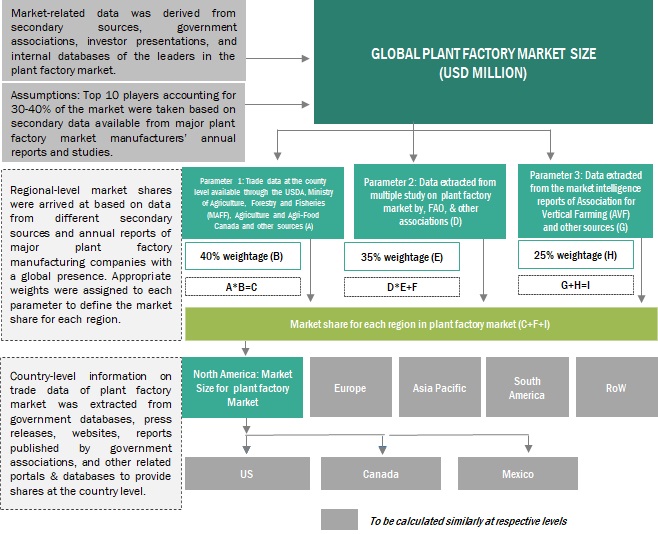
Data Triangulation
After arriving at the overall market size from the estimation process explained above, the total market was split into several segments and subsegments. Where applicable, the data triangulation and market breakdown procedures were employed to estimate the overall plant factory market and arrive at the exact statistics for all segments and subsegments. The data was triangulated by studying various factors and trends from the demand and supply sides. The market size was also validated using both the top-down and bottom-up approaches.
Market Definition
According to Ministry of Economy, Trade and Industry (METI), the plant factory is a facility that aids the consistent production of high-quality vegetables all year long by artificially regulating the cultivation environment (such as light, temperature, humidity, carbon dioxide concentration, and culture solution), and enables farmers to plan production.
A plant factory is a commercial plant-growing facility that helps facilitate the constant production of crops throughout the year. It uses high-tech automated processes to produce yields, including monitoring of aspects such as light, moisture, carbon dioxide, and temperature. Plant factories are conducive to economies of scale as they enable cost, quality, and quantity control against the required harvest time.
They can be further categorized by growing systems, facility types, light types, and crop types. The advent of Controlled Environment Agriculture (CEA) as an alternative to conventional agricultural methods has provided lucrative opportunities for producing a higher yield of better quality.
Key Stakeholders
- Government regulatory authorities and research bodies
- Original Device Manufacturers (ODMs), Original Equipment Manufacturers (OEMs), and technology solution providers
- Artificial intelligence and machine learning system providers
- Importers & exporters, traders, distributors, and suppliers of plant factory
- Grow media, crop protection chemical, and fertilizer manufacturers and raw material suppliers
- Horticulture lighting, irrigation, and remote sensing equipment manufacturers
- Organic certification agencies
Report Objectives
Market Intelligence
- Determining and projecting the size of the Plant Factory market based on growing system, facility type, light type, crop type, and region over a five-year period ranging from 2023 to 2028.
- Identifying the attractive opportunities in the market by determining the largest and fastest-growing segments across the key regions
- Analyzing the demand-side factors based on the following:
- Impact of macro- and micro-economic factors on the market
- Shifts in demand patterns across different subsegments and regions.
- Providing detailed information about the key factors influencing the growth of the market (drivers, restraints, opportunities, and industry-specific challenges)
- To analyze the opportunities in the market for stakeholders and provide a competitive landscape for market leaders.
- To strategically profile the key players and comprehensively analyze their core competencies.
- To analyze competitive developments such as joint ventures, mergers & acquisitions, new product developments, and research & development (R&D) in the Plant Factory market
Competitive Intelligence
- Identifying and profiling the key market players in the Plant Factory market
- Providing a comparative analysis of the market leaders based on the following:
- Product offerings
- Business strategies
- Strengths and weaknesses
- Key financials
- Understanding the competitive landscape and identifying the major growth strategies adopted by players across the key region.
- Analyzing the value chain and regulatory frameworks across regions and their impact on prominent market players
- Providing insights into the key investments and product innovations and technology in the Plant Factory market
Available Customizations
With the given market data, MarketsandMarkets offers customizations according to the company’s specific scientific needs.
The following customization options are available for the report:
Geographic Analysis
- Further breakdown of the Rest of Europe plant factory market, by key country
- Further breakdown of the Rest of Asia Pacific plant factory market, by key country
Segmentation Analysis
- Market segmentation analysis of other types of plant factory




 Generating Response ...
Generating Response ...







Growth opportunities and latent adjacency in Plant Factory Market